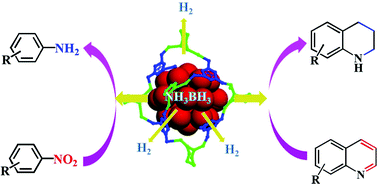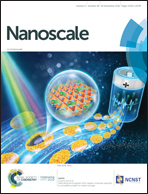Ru nanoclusters confined in porous organic cages for catalytic hydrolysis of ammonia borane and tandem hydrogenation reaction†
Abstract
The fabrication of narrow-sized metal nanoclusters for heterogeneous catalysis has attracted widespread research attention. Nevertheless, it is still a significant challenge to fabricate highly dispersed metal-nanocluster-based catalysts with high activity and stability. In this study, 1,3,5-benzenetricarboxylate and 1,2-diaminocyclohexane were used as precursors to fabricate porous organic cages (POCs), CC3-R. CC3-R exhibited a high specific surface area and a microporous–mesoporous structure. In addition, ultrafine Ru nanoclusters were successfully encapsulated in CC3-R with high dispersion via impregnation and subsequent reduction, affording Ru nanoclusters with a precisely controlled size of ∼0.65 nm. As-obtained Ru(1.45%)@CC3-R exhibited significantly enhanced catalytic activities toward the hydrolysis of ammonia borane (AB) and exhibited high conversion and selectivity for the tandem hydrogenation of nitroarenes and hydrogenation of quinoline in water under mild conditions. In addition, the Ru(1.45%)@CC3-R catalyst exhibited high stability and good recyclability. This study should provide a novel strategy for fabricating highly dispersed ultrafine nanocluster-based catalysts for various catalysis applications.

- This article is part of the themed collection: Editor’s Choice: Single-atom and nanocluster catalysis


 Please wait while we load your content...
Please wait while we load your content...